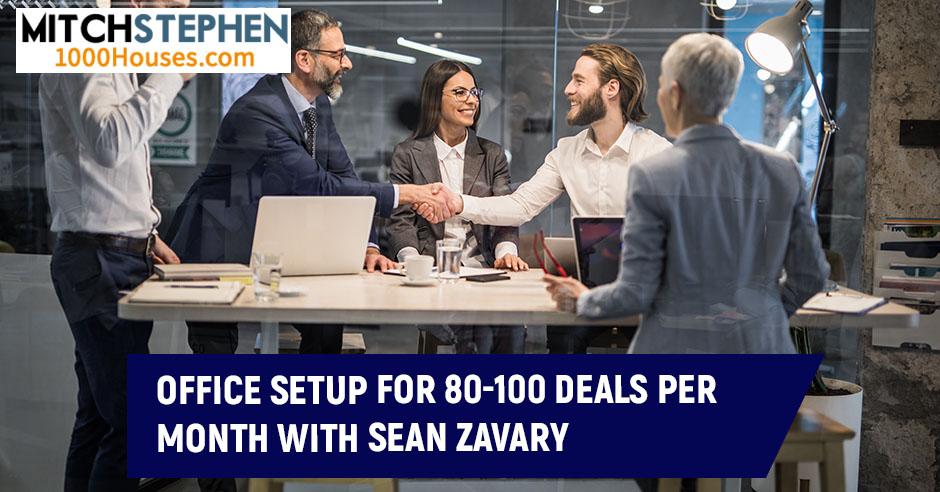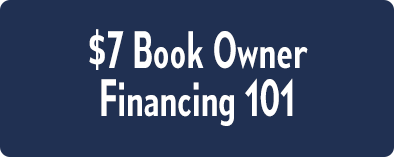PODCAST
Office Setup For 80-100 Deals Per Year With Sean Zavary
Episode 537: Office Setup For 80-100 Deals Per Year With Sean Zavary

What does an office setup for 80-100 deals per year look like? Mitch Stephen sits with Sean Zavary, who does 7 figures/year wholesaling and flipping houses. Sean shares how he has about eight people on his team. Half of them are in the office, half are virtual – that’s why he calls his company “hybrid.” His executive assistant is in the Philippines, his first hire since 2017. Join the conversation to discover the different departments and roles in Sean’s team. You’ll also learn how to maintain effective communication with your team members. Tune in!
—
Watch the episode here
I’m here with Sean Zavary. He’s out of Houston, Texas. This man has bought 80 to 100 houses a year for the last few years. We are going to be talking about wholesaling and flipping. How are you, Sean?
I’m doing fantastic, Mr. Mitch. How about you?
I’m doing well. Thanks for taking the time to come to the show. Give us a brief background. How did you get to this point?
I got into the real estate industry years ago right when I graduated college when I was 22, 23 years old. I was working with my family’s business before that. We have a retail furniture store called Exclusive Furniture. It’s an empire. They have seven locations all around town. Stores are 40,000 square feet plus. The warehouse is 800, 850 or 150,000 square feet plus. I was working with them for about seven years. As I was getting closer to graduating college, I started thinking, “Am I going to do this for the rest of my life?” The plan was to do our family business for the rest of my life. I’m the youngest sibling. I have 2 older brothers and 1 older sister.
Dad started this company back in ‘98. It was a seasoned company in 2016 when I was having these second thoughts like, “Am I going to stay here? Am I not?” Long story short, I self-evaluated and figured out, “This is not what I want to do for the rest of my life. I don’t want to deal with furniture. I want to be in the retail world for the rest of my life.” I looked at all the other industries and saw what I was good at.
When I worked with my family, I wore different hats. I was doing warehouse management, doing deliveries, sales, inventory, a lot of accounts payable and receivable, and a lot of different things. I started self-evaluating what I enjoy the most, which was sales. I was like, “I’m going to get into the sales industry.” Slowly but surely, real estate stumbled upon.
How did you stumble into real estate?
My girlfriend at the time, who is my wife now, was working for a builder who was out in Sugar Land selling a bunch of new homes. She was an assistant to the sales rep. As I was talking to her and figuring out what’s my next goal, my next step or my next career path, she was like, “Have you thought about real estate?” I was like, “I haven’t thought about real estate.” She’s like, “My boss who’s a salesperson locked in about $600,000 in a year.” I was like, “Real estate is the answer. Let’s go.” That was it. Long story short, I went to real estate for the money.
Did you go in as a real estate agent?
That’s what got me intrigued by real estate. I was like, “Real estate is the answer.” As I started researching real estate, reading books, and going on different blog posts like BiggerPockets, one night, I was like, “There are real estate agents and real estate salespeople who sell new homes. Some investors fix and flip houses like HGTV. I like the fixed and flip. I want to go the investor route.” I started researching real estate investing and how do I get into it in my last semester in college. While I was in college, I forgot what class I was in.
I was on Instagram and got a sponsored ad from a guy named Nick Ruiz. I don’t know if you are familiar with who Nick Ruiz is. He was saying, “You can buy properties with no money and flip properties.” I was like, “That’s intriguing.” I clicked on his ad and saw that his students were making $25,000, $20,000, $15,000 flipping houses or doing wholesaling. I was like, “What is this?” I started digging more into real estate wholesaling. After that, I bought his course. By the grace of God, he had a course that had a special probation promotion that went on in the month when I was graduating for $2 a month. I was like, “I will go ahead and buy it.”
After the $2, I renewed $99. I went ahead and bought his course for $2 a month and learned a little bit more about what real estate wholesaling was. I ran into Sean Terry’s Flip2Freedom Podcast. It was that podcast and Nick Ruiz’s alpha flipping course that got me started in real estate. They said, “Put a banner sign up.” I put a banner sign. They said, “Send letters to sellers.” I send letters to sellers. They said, “Go driving for dollars.” I went driving for dollars. That’s how I land for my first deal.
Did you start full-time in 2019?
No, I started full-time in 2016. May 31st, 2016 was when I first put a bandit sign out. That was my first marketing channel with it and when I officially started my real estate investing wholesale.
If they can do it, so can you. Share on XYou have ramped up pretty quickly. I was noticing in years to be doing 80 to 100 houses. You are a sophisticated, smart, driven person. To you and me, it might look easy but there’s some talent to it because I know a lot of people that can’t do it. I don’t know why they can’t do it but it’s a lot of different factors. It takes some dedication.
You don’t start a cannon if you don’t know anything about it. It’s like anything else. You’ve got to learn to walk before you run. With wholesaling, 97% of the people start in that business like you. I didn’t start that way. I didn’t even know what wholesaling was back then. I was buying houses, creating notes, and selling the notes. That’s how I started.
I was buying houses on my credit cards because in 1996, in this town behind me, the silhouette of San Antonio, Texas, in the lesser parts of town, you could pick up houses for $8,000, $10,000, $12,000, and $15,000 years ago. I was buying houses on my credit cards, taking another credit card to fix it, selling it, owner financing, and selling the note. I did it 100 times in a row but most people started wholesaling, which is a great way to start.
I see it as the gateway drug to getting into real estate. You learn so much wholesale. You learn the lingo or the verbiage and how to market. Once you learn how to do wholesaling, then you hold the value. You can go ahead and wholesale, fix and flip or buy and hold this property. You can use those strategies that you learned in wholesaling, which is a marketing and acquisition company to any other business that you want to get into because that’s what it is. It’s a marketing acquisition.
Marketing acquisition in that first house, even if you make a little profit. It’s a huge revelation. I had no money. I took my expertise and my time and I generated a check. Tell me about your first deal.
My first deal was from a bandit sign that I put out because I used to put bandit signs. That was my marketing strategy. In Houston, I became known as the bandit sign guy because I was putting it out. In the beginning, it was me learning the business. When I stopped my family’s business and went different ways, I still had a sufficient savings account. I had money saved up, so I knew that I was not going in with no money but then I was only starting the business.
I was putting up 100 bandit signs a weekend or 100 bandit signs on Friday and Saturday night until I started finding traction and then hiring guys out. Back to your question on how my first deal was, from a bandit sign that I put out, Ms. Ruby called me. I still remember her address. That deal didn’t change my life entirely but I figured out this is real.
I already knew this was real because I was in Nick Ruiz’s course. Most of the time, what I would watch is the testimonials of other people saying, “I did this and that. I’ve got this much.” That gave me the belief, “This is true. If they can do it so can I.” Once I’ve got that first deal, it opened up the gates and got me momentum. With my 1st deal, I was 2 months into the business, putting bandit signs and sending letters consistently seven days a week. When I was not sending letters, I was driving around for dollars. When I was not driving around for dollars, I was putting out bandit signs on Friday and Saturday nights.
Ms. Ruby Davis called me out to her grandmother’s house where she had been baking for about eight years. She was like, “I’ve got this property. I don’t think there’s much to it. Can you go ahead and come look at it?” I went out there and looked at it the next day. We couldn’t even get in. It was a condemned property and a teardown. I didn’t know what area it was because I didn’t know too much about where the hotspots whereas I do now. She owed $15,000 in back taxes. It was her and her two other siblings. They wanted $15,000 to walk away with.
That was another $15,000, about $30,000. I went back and forth. I have a sales background. I went ahead and got her down to $23,000. I gave her $23,000. I signed the contract right then and there. As I’m leaving the appointment, I’m driving around for dollars because that’s what I was taught.
When you leave an appointment, whatever house you are at or wherever you go, make sure you drive around the neighborhood. Look for other distressed properties for sale by owners. I’m driving around the neighborhood.
After I’ve got that property under contract, I see a For Sale By Owner sign. I call that and was like, “How are you doing? I saw this property that you have for sale.” “I’m not selling a property. It’s that little lot on the corner.” I’m like, “You are selling this little lot?” “Yes.” I’m like, “I only pick up a house.” That for sale by owner turned out to be a buyer. I told him about the property that got put under contract. He goes, “I’m interested. Can I come to look at it?” Within an hour, he came and looked at the property that I put under contract. He liked it. He said, “What’s your price?” I was like, “I don’t know, $40,000.” He goes, “It’s a done deal.” He shook my hand and goes, “Let’s go to the title company and put the earnest money.”
I was like, “You are ready to go?” He goes, “I’m ready to go.” I was like, “Let’s do it.” We went ahead and he signed the contract right then and there. I didn’t have this under contract. We went to the title company. They put out an assignment contract for us. We signed the earnest money to the title company and that’s how I locked in my first deal.
You made upwards of $10,000 in your first deal. That’s an eye-opener. It shatters a lot of limiting beliefs like, “I need money to start this business.” If everybody needed money to start the business, no one would ever start because everyone I know started broke pretty much and scared. Were you married when you did this first deal?
No, I wasn’t married. I had a girlfriend, who’s my wife now.

Office Setup: Start researching real estate by reading books and going on different blog posts.
It sounds like you had the support of your significant other. A lot of people sometimes aren’t that fortunate.
I also had the support from my family, my mom, especially because it was a big thing for them. They are like, “You are leaving the family businesses and doing your own thing.” They were shocked a little bit but they supported me. That was shocking for me that they were like, “Go ahead and do what you want to do.” That meant the most to me that my family was supporting me. I had my girlfriend who was supporting me.
We ended up working together. About six months in, she saw that I was getting some deals. She was like, “I’m going to quit this job and start working with you.” I was like, “I don’t know if I have anything for you to do. I’m only a one-man show.” She goes, “We will figure something out.” She ended up quitting. The next day after we had this conversation, she was like, “Where do I meet you at? We are going to go ahead and start this thing together.” I was like, “Let’s do it.” She and I ended up partnering up.
What income did she walk away from?
She walked away from about $4,000 or $5,000 a month to $48,000 or $60,000. She was still in college but she knew that that was not her. She was an assistant for the sales rep and then did some other stuff for them.
I was pointing out that you took a leap of faith, gave up, and decided to put all in, which is a scary thing. I never suggest that people leap, quit their job, and run into this. I say, “Burn the candle at both ends for a little while and prove a couple of deals. Put $7,000, $8,000, $15,000, $20,000 in the bank, and then once you are a little more confident, only you can decide when to do it.” I never tell anyone to jump out and quit to see if this business is for you because these TV shows and HGTV are all glossing over it all. They do 2 months of rehab in 30 minutes. It looks easy.
It’s not for everyone. A lot of people try but they can’t accomplish it for some reason here and there. There are a bunch of reasons why. It’s a simple business but it’s not easy.
When you first started, you and your wife are wearing all the hats. It sounds like your business has morphed into a different thing because you couldn’t buy 80 to 100 houses, fix them, sell them and handle everything by yourself. Tell me what your office has evolved to.
We have about eight people on our team. Half of them are in office. Half of them are virtual. We have a hybrid company, you can call it. In the office, we have our disposition agent, who is also our Transactional Coordinator. That’s one person. Her name is Ashley. We have two acquisition guys who are in the office as well and then we have me. That’s four people that are in the office. That’s the acquisition department and the disposition and transactional coordinator who deals with all the title work and all that good stuff, selling the deals. Overseas, we have my Executive Assistant, Michelle, who is in the Philippines. She has been with me the longest. She was my first hire back in December of 2017.
I want to point out real quick. He sells real quick and needed help, so within a year of being in the business, he’s got someone to delegate something to. He got to start offloading stuff relatively quickly because, with the burnout factor and the mistakes that you make when you are doing any volume beyond whatever your capacity is, and then you don’t have anyone to help you, it can get pretty muddy. Did you feel that? You did. You even hired a VA.
My wife and I are running around like chickens with our heads cut off. We did a lot of volumes. We had a great time but at the end of the year, we are like, “That was great but we do not want to do that again.” It was too much. It’s not sustainable.
What does this VA do for you?
She’s on a lot of things for me. She has been with me for five years. She does our KPIs.
Explain KPI.
Learn while you’re working in the business. Share on XKey Performance Indicator, what are our acquisition guys making and how many offers are they making. Out of those offers, what contracts do they have? She does our profit and losses. How much was our revenue for March 2022? How many properties did we assign for March 2022? Out of those properties that we assign, how many dropped? She has all these numbers for us. I’m just looking at it from a CEO’s position.
When did you start out paying this VA? Where is she at?
We started off paying her about $5.25 an hour. Now, she’s paying $7.75.
I’m assuming you will take care of them with little bonuses and things along the way?
She gets taken care of well. Every quarter, she gets anywhere from a $200 to $300 bonus like at Christmas. One time, I gave her a bonus of $500 but I don’t like to give them too much because you’ve got to understand the ratio there.
I was going to point that out. $7 an hour over there, it’s like $50,000, $60,000 a year here. People that make $7, $8 an hour in the Philippines plus their bonuses and stuff have servants. The servants over there are $1 an hour or $0.50 an hour. I haven’t been there. I don’t know but it was very cheap and it’s all related. It’s the peso system over there in the Philippines. I forget what the exchange rate is, 20 to 1 or whatever it is.
It turns out there’s a whole ton of things you can do. If you go to 1000Houses.com/VAHelp, you can see a company there that will find VAs for you. Most of these are trained already because there are a lot of VAs that know how to work in this industry. That’s a salary but it’s a pretty nominal salary certainly for the work that they do and for the load they can take off your shoulders. Let’s talk about your acquisition guys. How do you pay them?
My acquisition guys are in the office. When they come into the company, they come in as a junior acquisition. Nobody ever comes in as a regular acquisition or senior acquisition. You’ve got to work your way up. When you come in as a junior acquisition, you get paid $1,600 a month, plus a 3% commission on any live transfers that you do. If you come in as a junior, what you are doing is calling leads that are already in our system, pre-qualifying them or getting them back on the phone because you don’t want leads to get into our system, which is a challenge. They are seeing if they do want to sell.
If our ballpark is in their ballpark price and they are motivated, they already do a live transfer to the senior acquisition who goes heads and closes the deal. If the senior acquisition closes the deal, the junior acquisition gets 3% of that cut. That’s only a temporary role. They are only in that role for about 1 to 4 months. It’s a stepping stone. They are learning our system and processes while they are in the business.
They are learning while they are accommodating. They are getting paid to learn and work.
Honestly, Mitch, within 2 to 3 weeks, we are able to tell, “This person is going to be able to get to that senior role or acquisition manager role.” After 1 to 4 months, they take the step up to an acquisition manager and then go from there. It’s $1,600 a month plus an incentive of $500 if they meet their KPIs. We are on a multiline dollar in our Podio system.
They need to be making 300 calls a day and 5 live transfers a week, meaning at least 5 qualified sellers. If they do 20 in a month, at least 3 of them need to turn into a contract, so 20 to 3 ratio. We are not too important with the calls. I’m not super strict on it. I’m looking for quality. The quality is live transfers to contracts. If they do that, then they get $500 for the month. That turns into a $2,100-month salary, plus a 3% commission. That’s for the junior acquisition.
Is the commission based on your acquisition price?
It’s based on our gross profit.

Office Setup: The acquisition people get tracked on how many contracts a week they put under a week.
They’ve got to wait until the deal is fully consummated. You are doing flips. They are getting paid that 3% when your money hits the table.
Yes, and about 85% of our business is wholesaling.
It’s a pretty quick turnaround then?
Yes, and 15% we are doing flips. We used to do heavy flips like $50,000, $60,000 rehabs, and all that good stuff but it’s not what I want my lifestyle to be. I don’t want to be doing $50,000, $60,000 rehabs.
Out of 100 houses a year, 70% are wholesaled?
Yes.
How do you handle your salesperson once she calls your disposition person? Is she also your closer?
No, she’s my transactional coordinator. She’s the one that helps with the title company, getting all the affidavits of airships or paperwork that the title company needs. She’s the liaison between the seller and the title company.
How does she get paid?
She’s getting paid $2,500 a month salary plus a 4% commission on the closed profit potential and then she gets paid $100 per transaction she closes. If she gets paid, it’s 4% anywhere from $0 to $20,000 profit, and then $20,000 to $35,000 is 5% and $35,000 and up. Anything that’s a $35,000 profit, she gets paid a 6% commission.
Everybody’s business is different. You’ve got to do what makes sense to you and be able to find and hold teammates. I don’t like to call them employees because they are probably subcontractors.
No, they are W-2. That’s why they have a salary.
It varies a little bit at my office for the sake of conversation for the audience. On our acquisitions, we give a little stipend, $1,600 a month for people that are being trained and then they get a small little piece of anything that consummates but we seller finance most of our notes. We don’t have a big payday paycheck.
We pay our acquisition guys when we borrow the money to buy the house because we are going to hold it for a long time. We also borrow whatever they are charging for the house. Their fee is included in my expenses to purchase the house and then I have my ratios that we have to be within. With the intern, we are getting that $1,600 a month stipend. They are either in or out pretty quick, paid upon success.
Start focusing on quality deals rather than quantity. Share on XI have two salespeople. They function off of six paid upon successes. I have very little payroll except for three administrators in my office that have to make everything run. We even tie them with little bonuses. We try to keep the salaries down and tie them to the success of the company too. They can make good money if the company does well. Trying to keep from getting on a hamster wheel that I can’t get off of. The sales guys are 100% but we are collecting $15,000, $20,000 and $30,000 down payments. It’s real easy to pay them out of that. They are 3% of the sales price.
The junior acquisition of $1,600 a month, plus the $500 incentive, which is $2,100 plus 3%. In the actual acquisition, once you graduate and you were able to close your deals, you get $2,000 a month plus a 7% commission, and then an incentive of $500 if you are able to reach your KPIs. They have different metrics we are tracking for acquisition agents versus junior acquisition.
It’s not live transfers. They are getting tracked on how many contracts they put under contract a week and things of that nature. If they hit those KPIs and get a $500 bonus, it’s $2,000 a month plus a 7% commission for the acquisition guys. Those are the two acquisition guys that I have in the office. I have three virtual acquisition guys. They get paid $4.50 an hour.
What they are doing is calling leads that are already in our system. It’s the same thing that the junior acquisition does. They are calling leads in our system, pre-qualifying them, seeing if they are looking to sell, and sending their motivation. Once they get on the phone and pre-qualify them, they do a live transfer to our senior acquisition who was in the office so they can go ahead and close it.
That live transfer is important because it’s hard to get these guys back on the line after they hang up. They don’t recognize the phone number that’s calling in. They are probably getting a lot of different calls if they are out there in the marketplace.
It is a business for us.
Our systems are the same but a little different but it’s that way with every office. There’s no right or wrong way, as long as you are winning.
As long as the outcome is income.
What’s a typical day for Sean look like that you have learned all this delegation?
My days have changed. Here’s a little background on my family. My girlfriend at the time is my wife now. We have two beautiful kids. I have a toddler and a baby boy. My time at the office has been very different than what it has been for 2021, for which I was very limited. Instead of working 40, 50 hours coming into the office from 9:00 to 5:00 or 9:00 to 6:00 that I used to do before I had kids, it’s like 9:30 to 3:30, 4:00, and still that. I leave the office by 3:00, 3:15 to go pick up my daughter from school, then go home.
After that, I’m home for the rest of the evening, helping my wife out with a newborn and having family time. I will still take some calls here and there but after 5:00, I’m done. I don’t take any calls. Anything that needs to be addressed gets addressed the next morning or through text message when the kids are asleep. My day typically looks very different. My team handled the majority of the day-to-day. I’m working on the business, not in the business.
On a typical day, I come in around 9:30 because I have dropped off my daughter at school at 9:00. I check the KPIs. We do meetings every day. Monday will be a team meeting. Tuesday, I will catch up on emails and a lot of different stuff that I need to be taken care of. I have other businesses as well other than the wholesaling business. I’m working on those. Wednesday, we do one-on-ones with the team members to make sure they are on the same page. We are practicing transparency. Thursday, the same thing, working on the business, making sure the KPIs are good.
I have a sales manager, so he does acquisition meetings. I’m not talking to sellers or anything like that. Friday, we worked from home. Monday through Thursday office is open from 8:00 AM to 6:00 PM, and Friday, everybody works from home. We have a Friday meeting at 9:15 AM that the whole team gets on to see what everybody is doing, how they have won the week, and stay in communication with the team. That’s pretty much it.
Is your office the house that you bought or are you leasing? Is it a freestanding building? What is it?

Office Setup: Let’s go ahead and create a win-win situation.
We are in a five-level building.
How much space do you have?
Above 1,400 square feet.
What’s that overhead?
About $3,000 a month.
I’m trying to paint a picture for people that are trying to get to where you are at.
Don’t get me wrong. You can get an office a lot cheaper but I’m in a good part of Houston. I’m not sure if you are familiar with Houston but I’m near Gallery, Highland Village area. I’m in a good part because I used to live in this area, so I wanted the convenience of being right next to my office. That was the reason why I chose this office. I fell in love with the building. We moved to Sugar Land in the suburb because I had kids. My wife wanted a bigger yard. The houses over here have small yards unless you want to pay about $1.5 million for a house, you get a little bit of yard.
We moved to the suburbs. I have about a 25-minute commute, which is still good but it’s in the middle of the city. My guys who are coming from Spring, it’s a 35-minute commute for them. My people who are coming South part of the town, it’s still a 30-minute commute from them. When we talk to sellers and tell them where we are at, that builds instant credibility. They come to our office. We have sellers coming over here. As soon as they would walk into the building, they are like, “Where are the contracts sitting out right here?” We have a nice office with a nice standing desk, which everybody has with nice chairs and little art pieces around here and there.
How are you funding your deals?
It’s through private money. I will do some hard money here and there if we do some quick flips like a house that we are buying for $65,000 for closing. I will give you an example. We are going to put about $15,000 to $20,000 into it. I don’t even think we are going to get to $20,000. It has new floors and we painted it as a hotel. We put it back on the market using our money. We have about $85,000 in. We can sell it for about $180,000 to $185,000. It will be a quick flip. With that, I’m using my cash but for other deals, we are buying properties for $110,000 or anything over $100,000 or rather not using our cash. We have private money lenders.
What rates are you paying for private money?
Private money is about 8% and that’s it.
How did you learn to raise private money? How is your private money stable? How did you build it up?
From my buyers. When I was wholesaling, I saw a lot of people who were buying properties from my cash. When it was time for me to be like, “Let me go take these properties down myself, go to those buyers who had bought for me a good amount of times and see if they want to lend some cash to me,” I would go to them like, “If I had a real estate deal, would you be willing to loan me on the purchase and the rehab?” It didn’t start with 8%. It started with 10% to 11%.
Give absolute attention to everything that goes on in your business. Share on XWhatever you work your way down?
Once we built that relationship, then we worked our way down to 8% and say, “I’m bringing you a lot of deals. I can still bring you more deals. I have other people who want to loan me but let’s go ahead and create a win-win situation. Let’s do 8%.” I have two people who loaned me 8% and some guys do 10%. If the 8% guys don’t want to do it, then I will have someone to do 10%. Sometimes they charge a 1% origination fee. They are more hard money but they are quick.
If I had someone at 10%, I don’t like to renegotiate with them. I will talk to the new people that show up in my life about 8%. I will leave the 10% guys alone. As I get enough or too much 10% money, I start talking to the new people about 8% and ratch it down. I wait until my 10% people and go, “Why aren’t you getting my money out?” I say, “I’ve got all this 8% money. I would get you out first but I have a fiduciary responsibility to my business.” If someone wants to loan your business at 10% or 8%, you have to spend the 8% money first. That’s why your money is sitting on the sideline, which is if they are going to convert or lower their rate, that’s when they would come at that point.
I never wanted to go back and renegotiate with anyone unless it was their idea and they started asking questions. I’m not saying, either way, is right or wrong. I’m telling you how I looked at it. I built it up. In the seller finance strategy, I have to borrow money for longer terms that are wrappable. I have to borrow money from my private lenders on a fifteen-year fully amortized to 8%. When I get that money out, their $100,000 or $200,000 is out. It stays out for a long time. I have to find another person. It’s not like a flip or a wholesale where the money goes in and the money comes back out.
My money is out there. That’s why my number is so big. Double-edged sword. People liked the fact that their money sits and they don’t have to be in and out all the time. There’s a lot less paperwork. They are collecting payments from me on their money every month on the first. It’s cool. Some people don’t want a loan that long. I’ve got a list of those short-term people that if I want to do a flip or I’ve got to grab some short-term money or some bridge money, I’ve got those people. They are all in different buckets. You go around and look at the buckets. That’s what you do.
Do you have certain criteria on owner finance only like $200,000 and below or is that a certain criterion that you do?
We will look at houses for $350,000 or under but the owner-financed homes are affordable homes. It’s the cheaper, $150,000, $175,000 or $200,000. We are looking at even up to $400,000 because if you can’t afford a $400,000 house for $250,000, I’m not going to seller finance it. It doesn’t make as much sense. Though, you can sell or finance those homes under certain conditions. Those homes would flip them. We will make the $200,000 spread or the $100,000 spread. Seller financing works best on affordable houses, on land or something a little cheaper, mobile homes, and land.
It’s a real pleasure to talk to someone who takes the bull by the horns and gets the distance that you’ve gotten in years. It’s impressive, Sean if you don’t mind me saying. You always go to give it up to the man upstairs because if he doesn’t want this to work out, it’s not going to work out. What were your thoughts when the pandemic was rolling around? Nobody knew what was going to happen.
I was going through a lot in the company because it was more of the team part of it. I had a huge team at one point, Mitch. I didn’t have this small lean team.
There’s a lesson learned.
I had a huge team. I had about 6 sales guys, 1 disposition agent, and 1 transactional coordinator so that was 8 people. I barely had any virtual people, only my two VAs that were doing texting, and Michelle was doing admin stuff. I had a huge team that I had to make about $75,000 to $80,000 a month to break even.
That’s scary, isn’t it?
It was scary but the crazy part is I did not know that when I was in it. When I was in the business, I didn’t know like, “I need to make $78,000.” I was only in it. I was going and we are knocking out deals. We are doing fifteen deals at that time. There were so many deals coming in and out. It was a zoo over here. At that time, I didn’t know until a blessing in disguise came where I found out something about those sales guys that I had. They were trying to do their own little thing, double dip the company. You know how they try to do that. I’ve got a catch of it, let a couple of guys go and some guys went out on their own.
When the pandemic hit, I was like, “We will cut down the team. We’ve got to all work from home.” We are on Zoom calls two times a day from 9:30 meeting and 4:15 meeting to catch up. We kept marketing. I didn’t stop marketing. We didn’t stop calling people. We kept doing our business. 2020 was the best year that we ever had. I have not had a better year than 2020 and it was the year of the pandemic. 2021 can count but it’s nowhere to be found.

Office Setup: The goal is to find another piece of land before the end of the year.
It was the best year because you didn’t quit. Everyone else quit and went home. You are the only guy who’s open. You were showing houses from the car. They meet out there in two cars, the guy would already have the door unlocked and be on speakerphone. The people would go to their car, walk through the house, get back in the car, and talk. You have to buy and sell or you don’t have a business. You have to figure it out.
A lot of people stop marketing, which is the worst thing you could do. It’s like the way business owners were scared of what’s going to happen next. Homeowners are scared too. They are thinking, “What am I going to do next?” We were continuing marketing and that’s where I’ve got a lean team where I ended up getting rid of the junk and the fact that we didn’t need. We had subscriptions that we were doing the same thing but we didn’t know we had subscriptions doing the same thing. Operation expenses can add up to you. We had operations expense that was high. Payroll and operations went down. We started focusing on quality deals rather than quantity.
In 2019, our average deal size was $12,000 a month. In 2020, it jumped up to $17,000. In 2021, we had $21,000 and 2022 is going to easily be over $30,000. We are dealing with quality deals. I’m talking about the wholesale side of it, not about fixing flips. It’s 70% of our business. At that time, in 2019 and 2020, I was 100% wholesaling. In 2021, we started dabbling into flips, hotels, and things of that nature. We’ve got some rentals as well but I’m not too fond of rentals. I don’t feel like I can live the life I want to live.
You are doing all these flips and stuff and you are making some money. What is your forever strategy? Do you have a forever strategy? For me, I do the one-time cash events, which are wholesaling or fix and flip. I do the temporary cash events, which is seller financing but I take the money I make from those two income strings. I’ve got to put it into something that’s forever, so I could work myself out of a job if I buy enough with this forever asset. My forever asset is self-storage. I have about 1,300 doors around Canyon Lake where I live in about 14 locations, self-storage, mini-storage, and climate-controlled storage. Not too much climate control but open parking and semi-truck parking.
When I own those, those will end when I say because I’m leasing that space. I have a landlord for that space but it’s not a landlord-like for an apartment complex, a house or a fourplex. I didn’t want to be a landlord for that product because there was too much pressure. When you move someone or have to force someone out of a house, there’s a lot of resistance. It’s much more arduous. I wanted to pick something else that didn’t have the resistance. If they didn’t pay me, I was able to repossess my unit or my property. What are you thinking? Have you thought about it yet?
I have thought about it numerous times. I don’t know if the individual that I spoke to before got into this meeting or introduction. I love self-storage. I started getting into self-storage but I wholesale those. One was I was supposed to close but he got into some legal issues with the son and the owner. I’m glad that you do self-storage. One of my forever strategies is office-warehouse flex spaces and triple net leasing. We are building one. I’m in the middle of construction. We bought a 1.4-acre land in Southwest Houston near the tollway and the 59 Freeway as well, so near freeways. We are in the process of building a 20,000 square foot flex space office warehouse. Flex space is 75% of it. I know you know what it is.
I’m not that much into commercial but I’m saying the flex space. There are doors but you can move the walls so they can get more or less space.
Let’s say, ideally, there are 2 buildings, 20,000 square feet together, 10,000 square feet each. 10,000 square feet each, we are going to rent about 6 units, so it’s 1,800 square feet a unit. Out of those 1,800 square feet, 75% of it will be a warehouse, and 25% will be an office. We will run it out to businesses as a triple net lease.
Triple net is great. For those out there that don’t know what triple net is, they are responsible for the rent, the property taxes, and the insurance. You are only responsible for major repairs like if the AC goes out or the roof starts leaking. You have to have the sound. It’s more of a dependable income. You know what’s going to come in every month because there’s not a lot of reasons for you to go back out. If you are a landlord of a house, you could get $2,000 in for the rent but if the air-conditioner breaks, you have to give the $2,000 up. It wasn’t even your money. In a triple net lease, it’s a little more predictable what you are going to make every month. I liked that.
That’s what we are doing. That’s my strategy. This is the first one that we are building. Our goal is to find another piece of land before the end of 2022 so we can go ahead and start the preliminary stuff for that second one. By December 2022, most likely, the first one that we are working on should end. That’s my first primarily focused on commercial real estate. I’m still not forgetting about self-storage because I love self-storage, also the whole RV parks, and everything like that. Self-storage is also something that I’m going to get into.
I wanted to take an educated guess here. The reason why you have two 10,000 square foot buildings is that if you have one 20,000 square foot building, you have to put in a sprinkler system. You have to put 10 feet between the buildings and save yourself $100,000 in sprinklers.
You are a smart man. Also, there are phases. I’ve got Phase 1, which wants to complete everything on Phase 1 but let’s say, we can do Phase 1, which is the 10,000 square feet, rent it out, stabilize it, go back to the bank, refinance it, get some money out, go in and do Phase 2, which is the other 10,000 square feet.
That’s a perfect concept. Before we build it all, let’s rent one piece and make sure this works out like we think it’s going to work out. It’s a pleasure to talk to you. I’m sure we can talk for a week and never stop because you are an amazing person and have done well. Hats off to you and your wife. Be careful with that one thing you said, “Learn to run as lean as you can,” because it all takes a toll. Every person you have takes a toll on you. It’s like babysitting for the longest time. Even then, my acquisition managers are 4, 6, and 7 years with me.
They are pretty much independent and know what’s going on but they still need help. They have not been in the business for many years. They don’t know everything that can happen and got to watch over. At the end of the day, it’s the owner’s money. If you don’t pay attention to it, it has a way of walking out the back door.
You need to have persistence and a good work ethic. Share on XPay attention to everything that goes on in your business here and there even though you want to work on the business. What you don’t pay attention to, you eventually stop caring about.
Everything starts with an acquisition. This business doesn’t work if you don’t buy something. I have a My Life & 1,000 Houses – 200+ Ways to Find Bargain Properties. Starts with the shoestring budget and how to find leads when you don’t have two nickels to rub together. As it progresses through the book, there are more sophisticated ways to mine for houses but they cost a little bit more money. You have to get VAs involved but it also becomes more automatic and you can start taking off your buying hat. You can back out of the building and watch acquisitions happen.
We are acquiring houses. My company may break a record in 2022 because we usually do about 100 houses plus or minus. We can handle that. You’ve got to have an infrastructure. If you get too much, your infrastructure starts to break down and then you start making stupid mistakes, which can cost you a lot of money. We are already approaching 50 houses for 2022.
It has been truly one of the toughest markets in a long time to find houses but people ask me why. I was talking to my partner, Mike and said, “Why do you think we are doing so well when it’s a seller’s market and there’s more competition than there has ever been?” What it boiled down to was our acquisition and sales guys are all veterans by now. They have spent many years in the game.
My youngest acquisition guy had only four years but won the trophy in 2022 for the most money made. Even my youngest guy is a superstar. All of them took 6 to 8 months to get enough wind underneath their wings so you can take your eye off of them for a second. Mike had a lot to do with that training. Not so much me. My job is to make sure that we have enough money. I had a book called The Art of Private Lending. I teach people how to lend their money and make 14%, 16%, and 18%.
For those people who would rather be a lot more passive and want to continue to play golf and enjoy their retirement, in the middle of the book, I say, “If you don’t want to do all this stuff, I already know how to do it. I’m willing to put your money out using all these same protections, paperwork, and everything but you can loan it to me. I will go out there, place this money and do all the heavy lifting. I will send you a check every month but I can’t pay 14% or 16%. I can pay you 8%,” which is a very preferred rate. To be able to put your money out at 8%, still, enjoy your retirement, and not have to worry about much of anything is a pretty protected position.
Mitch, hats off to you for having guys for that long, especially in the acquisition department.
If you want to go into that, maybe it will be helpful for you because one of the problems is once they get good, they may have visions of going out on their own. We tested our guys on a personality test. We wanted all the good stuff, responsibility, integrity, punctuality, and organizational skills. The only thing we didn’t want them to have was a huge entrepreneurial bone in their body, so we tried to make sure of that but they had everything else. Even then, you believe that a person can learn to be an entrepreneur or they might jump out and overestimate themselves, or underestimate the size of the job. It was all during the time that we had them.
This was not a con job. It was a sales job or educational task. We constantly explained to them, “You could go out on your own and then have an administrative assistant and office space. Why don’t we make it where it all works? I don’t make all this money. I have to give something to you and the office space. You are not making all the money. Let’s go fix it so that we are all accomplishing our goals and be responsible for everything ourselves. If you go on your own, you will have to start this whole thing by yourself or downsize and not do so much volume.”
After they have been with us, have several houses, and reached a threshold, their LLC will partner with me and Mike’s LLC on seller-financed homes so that they can start building a residual income that comes in, whether they did anything or not that month. The object is not to get them to want to sit down but the object is it’s like attorneys. If you’ve got a good attorney and he’s bringing in a lot of cases, winning a lot of cases, and making your law firm a ton of money, if you don’t put his name on the board and give him some incentive from the bottom line of the company, then he’s going to go out and start his firm.
He’s taken all that legacy knowledge that you have, probably going to take some of your customers and bite into your market. Why don’t we address it ahead of time? We start grooming them that we are going to be together for a long time because it makes sense. You have to pay them accordingly as they get better. They have to move up the ladder. They also have to be able to do some investments either on their own or with us. We prefer that they do it with us.
We will provide the money. You find the deal. We will put it to our servicing company and do seller finance notes. You will have some money coming in that you can count on every month and not have to start from zero on the first of every month, go out and make something happen. We still want you to make things happen but we would also like to give you some peace of mind. Anything you would like to say to maybe the new guys out there before we wrap it up?
Honestly, real estate changed my life and development-wise as well. You get surrounded by so many individuals who strive for greatness. Advise to get into real estate is if you want to get in and this is something that you know you want to get into, first, you’ve got to figure out why you want to get into it. Once you figure out why you want to get into it, then you’ve got to go all in. This is not something that you half-ass and is like, “Maybe this is going to work. Maybe this is not going to work.” It works. You’ve got to put the work in, be persistent, and have a work ethic.
In the beginning, you’ve got to have the hustle mentality. Go in and know that it’s not going to come easy. There are going to be ups and downs but it’s going to be all worth it in the end. As cliché as that sounds, it’s true. I didn’t know what I was getting myself into until I got into it but a lot of people try to plan things out like, “This is what I’m going to do.” Get into it, and then figure it out as you are into it. That would be my advice. Go all in.

Office Setup: You can just hire somebody who can get you there the shortcut way.
One last question, a quick answer. How much have you spent on education?
A lot of money. In 2021, I spent $60,000. I have been in Mastermind since 2017, spending anywhere from $20,000 to $30,000 on one Mastermind. I have been in numerous Masterminds but as an average a year or altogether, it’s six figures for sure.
I want to point it up. You are either going to pay the street, some mentors or coaches. Education will never be free. You might think, “I’m going to do it on my own.” You are going to get yourself handed to you somewhere or you are going to be walking past all the kinds of things you could have done but you didn’t know. You left that money laying on the sideline.
It’s going to take a lot longer to get where you want to be. With books and education, you might get there but it’s going to take you a lot longer than the other guy who’s fighting the shortcut, getting into Masterminds, getting into people who are like-minded individuals or hiring that coach that has done it already. You want to be where they want to be. You can hire somebody and be able to get you there in a shortcut way.
We spent $30,000 if you go to a Mastermind to learn how to get out of our business, how to back out of it and it still runs. It took about fourteen months getting this one person, getting everything spelled out, firing that other person, and having to start over in that chair again. One by one, we found the right people in the right place. It’s very lean. It’s as efficient as we have ever been. Thank God. We can run at a pretty good clip about 100 houses a year but we have 50 properties in the 1st quarter of 2022. I would like to thank you for taking the time to come on. I appreciate you. Hats off to you and your wife. What’s your wife’s name?
Nissa.
Nissa, great job. Keep this guy on the track. Don’t let him do all this stuff. Keep him down in the middle.
I appreciate the mention. Hats off to you. You have been in the game for a long time. You are a pioneer in the real estate world. I appreciate everything that you are continuously and still doing.
I appreciate it. I would like to thank you for joining this episode with Sean Zavary. He’s not a coach or selling anything. We wanted to break it down and show you what his office looked like, how he figured out to get lean and delegate so that he could have a life, have a great income, still be out there pushing and be on the horizon.
If they want to follow me, it’s Sean Zavary on Instagram. I started becoming active on TikTok. I’m part of a 50-day TikTok challenge with my cousin. I put a bunch of value and knowledge out there for anybody who wants to get in or get their mind right. Follow me on TikTok and Instagram. Shoot me a DM if you need to know more. I’m an open book when it comes to it. I want to be able to help as many people as I can because when I was getting into this industry, there were a lot of people that reached out to me and they helped me out. I want to be able to give back as well.
We are going to post everything over and it’s going to be 1000Houses.com/seanz. I will talk to you soon. Thank you so much. I hope you have a great year.
I appreciate it, Mitch. Thank you.
Important links
- 1000Houses.com/seanz
- 1000Houses.com/VAHelp Find the Perfect Virtual Asst
- 1000Houses.com/tff Tax Free Future Consult
- 1000Houses.com/coaching Mitch’s Coaching Programs
- 1000Houses.com/aof The Art of Creative Real Estate Investing
About Sean Zavary
 Been in the real estate industry for 6 yrs. My company does 7 figures/year wholesaling & flipping houses. We have been consistently doing 80-100 transactions a year for the past 3 years w/ 52%+ net profit margins.
Been in the real estate industry for 6 yrs. My company does 7 figures/year wholesaling & flipping houses. We have been consistently doing 80-100 transactions a year for the past 3 years w/ 52%+ net profit margins.
Love the show? Subscribe, rate, review, and share!
Join the Real Estate Investor Summit Community:











